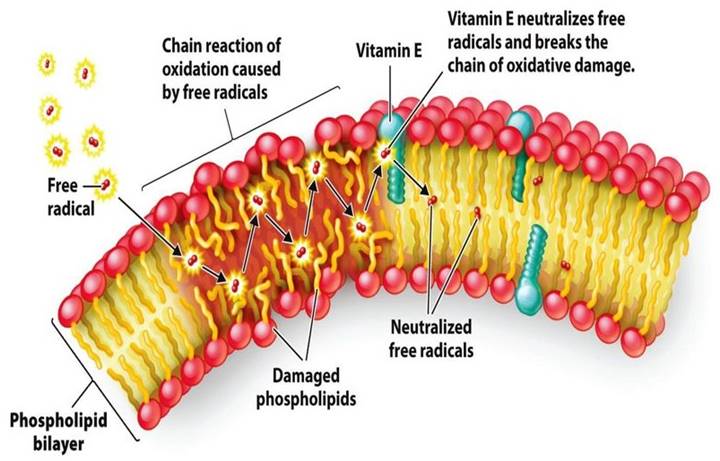Vitamin E is the collective name for a group of fat-soluble nutrients that function as antioxidants to protect cells and tissues. Antioxidants protect cells from free radical damage. Sounds like a sci-fi movie but actually, free radicals are all around us (and we even create some ourselves).

Free radicals are unstable molecules that damage cells, some well-known examples we’ve likely all had exposure to include:
- UV rays
- Exercise
- Cigarette smoke
- Environmental pollution
- Standard American Diet (SAD)
- Alcohol
Vitamin E is unique in that it is fat-soluble and literally weaves itself into the fatty outer layer of the cell (the cell membrane) to stand guard and neutralize damaging compounds.

The benefits of vitamin E extend beyond its antioxidant capabilities. It also disrupts platelet aggregation, meaning it has a slight blood thinning effect. In this capacity, it may have a positive impact on cardiovascular health – allowing blood to flow freely through blood vessels. This same effect is observed in other heart-healthy nutrients like omega-3 fatty acids and curcumin.
Let’s do a deeper dive into the various health benefits of vitamin E.
- Helps reduce oxidative stress
Antioxidants are substances that protect cells from the damaging effects of free radicals, in our environment or produced endogenously. Free radicals are unstable molecules that contain an unshared electron. Free radicals damage cells and might contribute to the development of cardiovascular disease and cancer sources of free radicals include those produced internally through physiologic stress like exercise and also environmental exposures including cigarette smoke (first and second hand), UV rays from the sun, and pollution. Vitamin E is a free radical scavenger, essentially diffusing the dangerous capabilities of free radicals and protecting cells in the process. Because free radicals have the capability to damage cell membranes, proteins, and nucleic acids, they can contribute to cancer risk. Take for example free radicals from UV rays causing skin cancer. Antioxidants including vitamin e, vitamin c and selenium may therefore play a role in cancer prevention and other chronic illness associated with free radical damage - Boosts Immune Function
Not only does vitamin E protect cells against damage but it also helps regulate immune function. Vitamin E is involved in the regulation of gene expression and cell signaling. Because of its role in immune function, it is found in higher concentrations in immune cells compared to other cells. In fact, research shows it is one of the most effective nutrients that keep the immune system running smoothly. Adequate vitamin E allows for optimal immune functioning, reducing the risk of infections. How? Vitamin E regulates T-cell function. T-cells are a type of white blood cell that play a key role in immunity. These cells circulate and identify foreign substances that need to be eliminated. Vitamin E affects T cell membrane integrity, cell division, and signaling. It also indirectly impacts the inflammatory immune cascade. - May Prevent or Delay Heart Disease
It’s not surprising that vitamin E may play a role in preventing or delaying heart disease since we know it functions as an antioxidant, protecting cells and tissues. Observational studies, looking at large groups of people have shown lower rates of heart disease among populations with higher vitamin E intakes. A study of almost 100,000 nurses found a 30-40% lower incidence of heart disease among those with the highest vitamin E intake. There are several proposed mechanisms for why vitamin E may lower heart disease risk. First, some studies have shown that vitamin E inhibits the oxidation of LDL cholesterol. Although most believe LDL cholesterol itself to be bad, it’s the oxidized form of LDL that contributes to arterial plaque formation vitamin E also thins blood slightly, which may help prevent the formation of blood clots. It’s important to point out that supplementation with vitamin E is not recommended, but both the American Heart Association and the American Cancer Society recommend food sources of vitamin E. More on that later…Finally, vitamin E helps keep blood vessels flexible so they widen. This helps blood flow freely while preventing catastrophic health problems like heart attack and stroke caused by blood clots and blockages from arterial plaque - Prevents and Treats Eye Disorders
Eye disorders increase with age. Two of the most common are age-related macular degeneration and cataracts. Oxidation and inflammation seem to be the main drivers of common eye disorders among older individuals. Several nutrients with both antioxidant and anti-inflammatory properties may help prevent and treat these common and life-altering conditions including vitamin E, zinc, vitamin C, and omega 3 fatty acids
Much like heart disease, large population studies show a lower incidence of cataracts and age-related macular degeneration among adults with the highest intake of vitamin E. This points to the fact that vitamin E may help prevent or delay cumulative damage to the eye that can lead to these common, debilitating conditions. Scientists believe vitamin E’s function as an antioxidant plays a strong role in this health benefit. Perhaps vitamin E limits damage from free radicals and keeps eye cells healthy and functioning optimally as we age. But food sources may be the key element here. The evidence regarding supplemental vitamin E is inconsistent however higher dietary intakes and blood levels among the general population are thought to be protective of eye disorders. Therefore, consuming foods high in vitamin E is recommended. - May Delay Cognitive Decline
Few health conditions are more terrifying than losing one’s cognitive abilities and yet there is so little focus on nutrients and other measures within our control to prevent and reverse cognitive impairment. The good news is, that vitamin E may provide some protection. Oxidative damage and inflammation in the vessels that supply blood, oxygen, and nutrients to the brain contribute to cognitive decline and several types of dementia, including Alzheimer’s disease. Vitamin E and other antioxidants may prevent some of the free radical damage and inflammation, especially in the polyunsaturated-rich membranes of the neuronal cells. Much like other chronic health conditions noted here, population studies show higher intakes may be protective whereas interventions with supplemental vitamin E do not yield the same results. A prospective cohort study of adults 65+ showed a less cognitive decline over a 3-year period in those with the highest intakes of vitamin E
Vitamin E Food Sources
Now, you may be wondering if you already get this supernutrient from your food and if not, what are the best sources of vitamin E? No this isn’t a picture of gumdrops, these bright-colored orange jellies are actually teeny tiny salmon eggs, also known as salmon roe, one of the best natural sources of vitamin E and its helpful transport mechanism – fat.
If you like this post, then share it and follow us on Instagram (@Basicofscience) many thanks for coming to our site Basic of Science, keep visiting our site for tips related to such health.
Disclaimer: Story tips and suggestions are for general information. Do not take these as the advice of any doctor or medical professional. In the case of symptoms of illness or infection, consult a doctor.